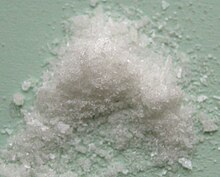 | |||
 | |||
| |||
| Names | |||
|---|---|---|---|
| IUPAC name Hexacarbonyltungsten | |||
| Other names Tungsten carbonyl Hexacarbonylwolfram | |||
| Identifiers | |||
3D model (JSmol) | |||
| ChemSpider | |||
| ECHA InfoCard | 100.034.423 | ||
| EC Number |
| ||
PubChem CID | |||
CompTox Dashboard (EPA) | |||
| |||
| |||
| Properties | |||
| C6O6W | |||
| Molar mass | 351.901 g/mol | ||
| Appearance | Colorless solid | ||
| Density | 2.65 g/cm3 | ||
| Melting point | 170 °C (338 °F; 443 K) (decomposes) | ||
| insoluble | |||
| Solubility | sparingly in THF | ||
| Hazards | |||
| Occupational safety and health (OHS/OSH): | |||
Main hazards | Flammable, CO source | ||
| Hazards | |||
| NFPA 704 (fire diamond) | |||
| Safety data sheet (SDS) | External SDS | ||
| Related compounds | |||
Other cations | Chromium hexacarbonyl Molybdenum hexacarbonyl | ||
Except where otherwise noted, data are given for materials in their standard state (at 25 °C [77 °F], 100 kPa). | |||
Tungsten hexacarbonyl (also called tungsten carbonyl) is an organometallic compound with the formula W(CO)6. This complex gave rise to the first example of a dihydrogen complex. [2]
Contents
Like its chromium and molybdenum analogs, this colorless compound is noteworthy as a volatile, air-stable derivative of tungsten in its zero oxidation state.



